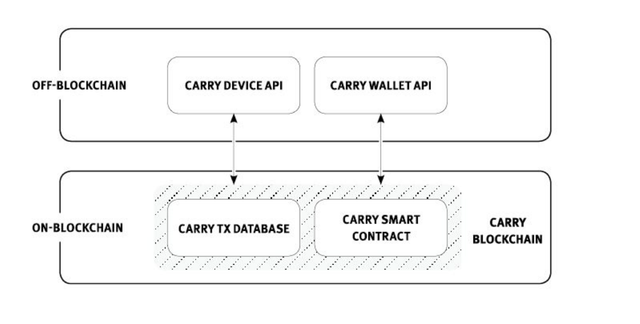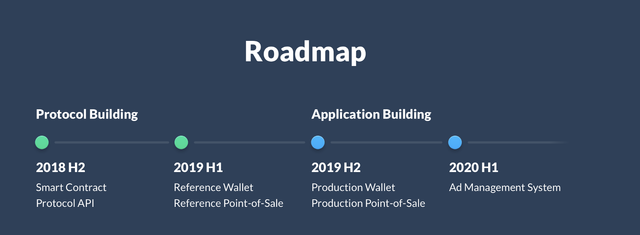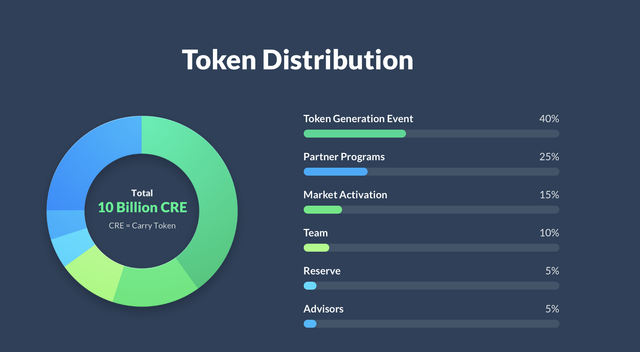Brief Summary:
Carry aims to solve some of the difficulties around the offline payment system model, as the customer data is incomplete for the merchants and on the other hand banks or the providers don’t have enough information on what the user is buying. Carry also is trying to solve the advertising difficulties that comes with the offline ecommerce models which is lacking transparency and effectiveness.
Carry will provide a platform for merchants to understand their customers and communicate with them and make advertising effective and transparent.
Detailed Look:
Carry has 2 main parts to it, Blockchain itself and the parts off-Blockchain.
Blockchain:
- This has a transactional database for the transactions on the chain
- To execute smart contracts and to issue and use the tokens (CRE and BT-Loyalty points)
Smart Contracts:
CRE- This is the main token
Merchants and Advertisers have 2 options to use the smart contract, (i) they can stake a certain amount of CRE on Carry Protocol or 2) pay-as-you-go (in CRE) for each use of Smart Contract. With option 1, if a certain defined limit is exceeded then an additional per transaction cost will be incurred by the Merchant.
CRE is itself a means of payment and an asset that can be traded at exchanges.
BT- Loyalty Points (BT)
BT is a reward token that can be issued by the Merchants and Advertisers for a defined monetary value and with some properties like expiry date or with interest rate etc.,
Carry protocol also aims to add more features on the smart contract going forward like store reviews etc.,
Off-Blockchain: APIs
Wallet API can be consumed by the 3rd party consumers
Device API supports communication between the device and the consumer’s wallet and provides the option to pay with cryptocurrencies.

These APIs will be consumed by the service providers who are: settlement service provider, wallet service provider, device provider, and advertising service provider.
Settlement providers helps in converting the Cryptocurrencies to fiat and take settlement fees as a charge towards their service. Wallet providers will provide wallets to the consumers and they consume the wallet API in the protocol, wallet will store the transaction data, use the cryptos, balances and acts as an advertising medium. Device providers consume the device API, it is the main interaction point between consumers and merchants and it also facilitates the interaction between the settlement providers. Advertising providers can conduct direct marketing and targeted ad campaigns.
Please refer to the whitepaper for a detailed use case to understand the business process flow.

Product status:
Prototype: Smart Contract and Protocol API built in H2 2018
Actual App: ETA is H2 2019
Ads integration: 2020 H1
Roadmap:
I will rate it as Medium as it is fairly long

Metrics:
Total Tokens: 10 B
For Sale: 4 B
It is hard to give a rating without knowing the hard cap- speculated around high 20M

Core Team & Advisors:
Core team doesn’t seem to have blockchain experience but the whitepaper has been written fairly thoroughly integrating business flows with blockchain tech.
Team has strong business flow knowledge and industry experience
They all have given their social media profiles
Advisors- looking OK
Partnerships:
Spoqa has partnered with Carry Protocol, they are the South Korea’s largest brick-and-mortar rewards platform
Investors:
Hashed is a well-known player in the industry and have an impressive track record such as KyberNetwork, OmiseGO, EOS and ICON.
Positives:
Carry will be implemented in 10,000 stores across Korea- Spoqa partnership will help Carry to be implemented seamlessly for 15M customers
- Development team understands the business model very well so this would be a huge bonus in the transition, note that Carry is founded by the co-founders of Spoqa
- Fiat to Crypto integration to real world is always a good thing at this juncture for the industry rewards for partner companies helps build the ecosystem
- Customers can get CRE for uploading transaction data and for accepting advertisements- this can be an added tiny bonus
- Integration of exchanges as settlement providers will make carry big over the time
Negatives:
- Fairly long roadmap
- Lockups on the Advisor, Team, Partners and the reserve tokens unknown
- Cannot see any blockchain experience behind any of the team members
- Unknown Hardcap (on the date this was written)
- No clear info on how wallet providers will make money for their services.
Conclusion:
Carry can quickly ramp up as the target market they are starting with is a great market to try a new thing out. Hardcap, team’s blockchain experience, 2019 roadmap are the main points to consider when the ICO comes around the corner.
Verdict: Carry will do really good if they reduce their hard cap below 20M as that is fair amount for what they are trying to do
Investing: On the wall- not decided
Score: I am no one to give a score- All these are my humble opinions
Disclaimer: This is not an investment advice. These are my humble opinions about the project and I request you to do your own due diligence.
hi friend , i invite you to be a friend and earn sdb by giveaways. only you need to a simple work answer to my daliy post and win sdb..so hope you join with mee. thank you
Downvoting a post can decrease pending rewards and make it less visible. Common reasons:
Submit